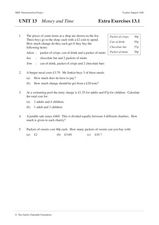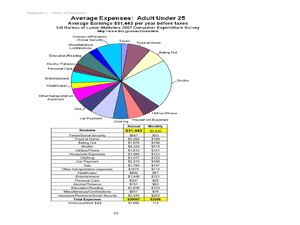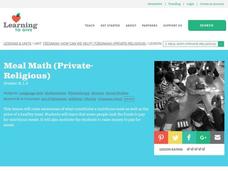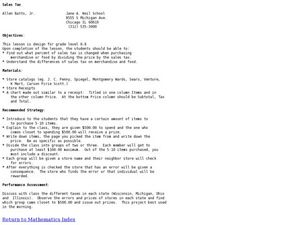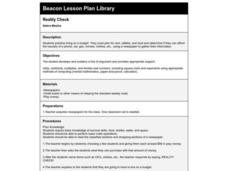Curated OER
What The Peanuts Say: Catabolism and Calories
Students investigate the energy released by a peanut and a piece of a walnut. In this catabolism and calories lesson plan, students burn a peanut and a piece of a walnut and measure the temperature of the water before burning and after...
Curated OER
Money and Time
In this algebra worksheet, students relate real world scenario to algebra. They use a mane to make choices when given a limited amount to spend. They complete a money maze and calculate the shortest distance between different cities.
Curated OER
Pumped Up Gas Prices
Students calculate gas prices. In this transportation lesson, students tally the mileage and gas costs of their car for one months. They figure out how much was spent on gas and create a graph showing average gas prices over time.
Curated OER
Thanksgiving Math
In this Thanksgiving themed math activity, learners calculate the answers to four word problems and then explain how they reached each answer.
Curated OER
Word Problem
In this algebra activity, students are asked to solve a word problem dealing with percents. They calculate the tip they should give to the waiter. There is one problem with an answer key.
Curated OER
Value of Education: Education and Earning Power
Students explore the earning power of someone with a post-high school education. In this education and income lesson, students evaluate examples of occupations, their salaries, and education level needed for the job. Students calculate...
EngageNY
Normal Distributions (part 2)
From z-scores to probability. Learners put together the concepts from the previous lessons to determine the probability of a given range of outcomes. They make predictions and interpret them in the context of the problem.
EngageNY
End-of-Module Assessment Task: Grade 7 Mathematics Module 4
Asses the class to determine their knowledge of proportional relationships involving percents. Class members work through the nine-question assessment with a variety of percent problems. The multi-step problems involve simple interest,...
Curated OER
Thanksgiving Dinner
Students plan a traditional Thanksgiving dinner. In this Thanksgiving instructional activity, students compare and contrast the first Thanksgiving to Thanksgiving celebrations today. Students plan a traditional Thanksgiving dinner and...
Curated OER
Tzedakah: How Can We Help?
Students define what constitutes a nutritious meal, the price of a healthy meal, and understand that some people can't afford healthy meals. In this healthy meals lesson plan, students estimate and research the cost of a nutritious meal,...
Curated OER
Tzedakah: How Can We Help?
Students identify nutritious meals and the prices of a healthy meal. In this nutritious meals lesson, students work in small groups and plan a menu for a nutritious meal. Students figure the total cost of the meal and collect money to...
Curated OER
Canine Companions
Learners identify the responsibilities of being a dog owner. In this animal welfare lesson, students list ten important items that a dog needs to live and visit a pet store to calculate the total cost of the items. Learners visit a local...
Curated OER
The Fuelish Fact Finding
Learners define fluctuation and the price of food. In this algebra instructional activity, students create a budget to live on based on their living expenses. They create a chart and explore the cause and effect of real life scenarios.
Curated OER
Drip, Drip, Drip or The Case of the Leaky Faucet
Students explore the cost of wasted water. In this math lesson plan, students conduct an experiment in which they collect data on how much water is lost when a faucet leaks. Students figure the cost of the water that was wasted.
Curated OER
Sustainable Dining
Students evaluate the how their product choices impact the environment. They discuss the concept of sustainability in agriculture. Students give reasons for buying sustainable food products. A cost-benefit analysis concerning sustainable...
Curated OER
Sales Tax
Students explore the concept of sales tax. For this sales tax lesson, students work in groups to spend $500. Students calculate the discount and sales tax on each item. Students buy between 5 to 10 items.
Curated OER
You'd Better Shop Around
Students compare and contrast the prices of various food items at different grocery stores using newspaper advertisements. Students discuss the benefits and drawbacks of shopping around for items that fit within their monthly budget.
Curated OER
Adding Two- and Three-Digit Numbers
In this adding two- and three-digit numbers worksheet, students, with a partner, problem solve and calculate the answers to eight mathematical word problems and equations.
Curated OER
Reality Check
Fourth graders practice living on a budget. They must plan for rent, utilities, and food and determine if they can afford the luxuries of a phone, car, gas, movies, clothes, etc., using a newspaper to gather their information.
Curated OER
Invest in Yourself
High schoolers develop the concept of finances. In this finance lesson, students watch a video called, "Moving Out." High schoolers calculate the finances of a character in the video. Students experience various budget scenarios such...
Curated OER
Budgeting and Travel
Students plan a trip to the Olympics. In this middle school mathematics lesson, students are given a worksheet describing the cost of necessities for their trip. Students are given a balance and must purchase airline ticket,...
Curated OER
Design-A-Meal
Third graders record what they eat for a week. In groups, they develop a menu for a fictitious restaurant. They create dinners which include all groups from the food pyramid. To end the lesson plan, they practice making healthy food...
Curated OER
Proof Sheet
In this career learning exercise, students identify and calculate their expenses if they had an apartment. They figure how much money they should save each month and budget.
Curated OER
BY THE POUND
The student will estimate the weight and cost of produce and calculate the actual price.Discuss the difference between weight and volume. Have students discuss whether it is more economical to buy produce by the pound, by the piece or...

